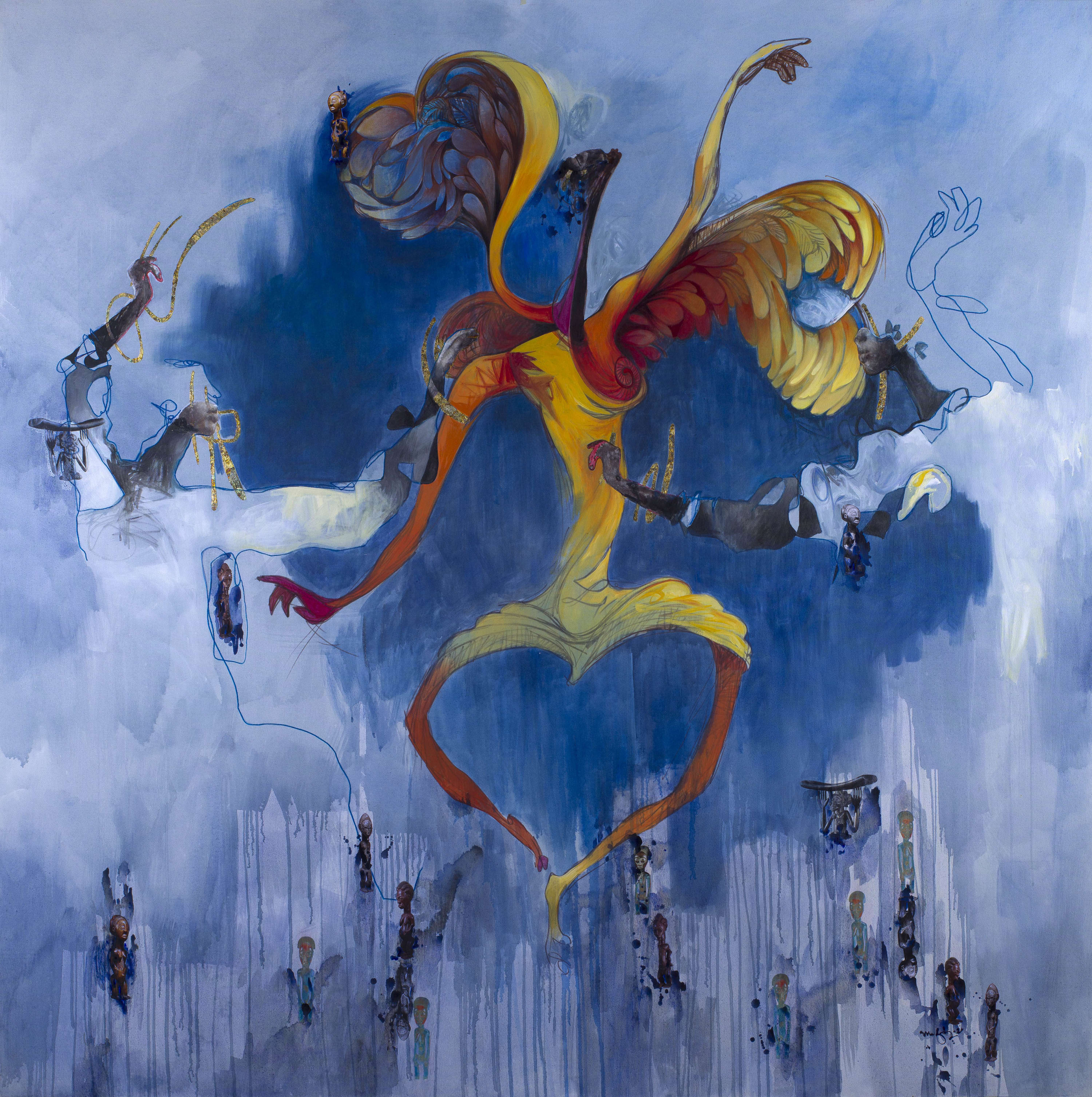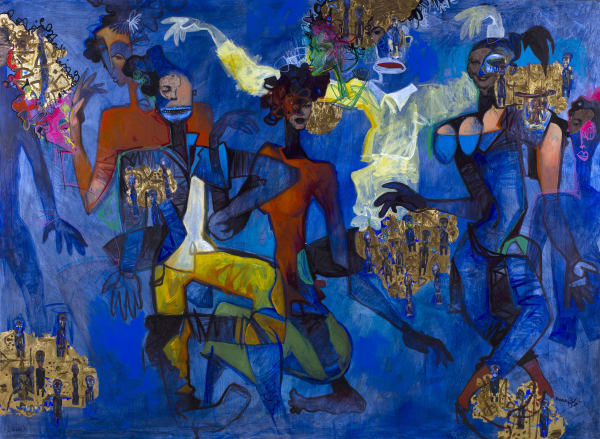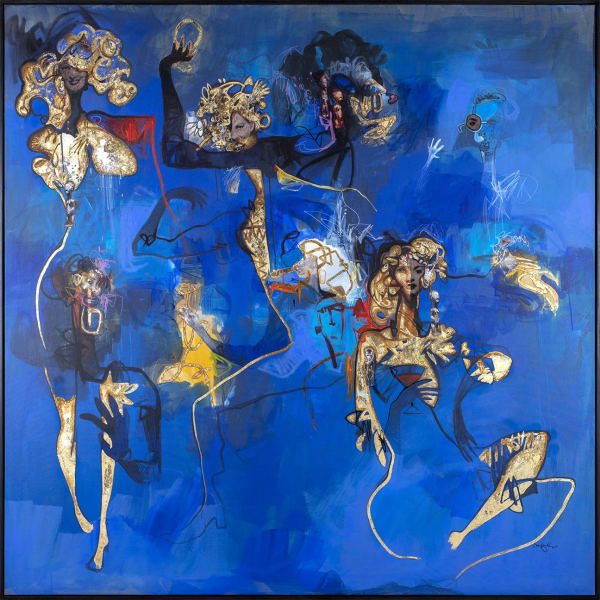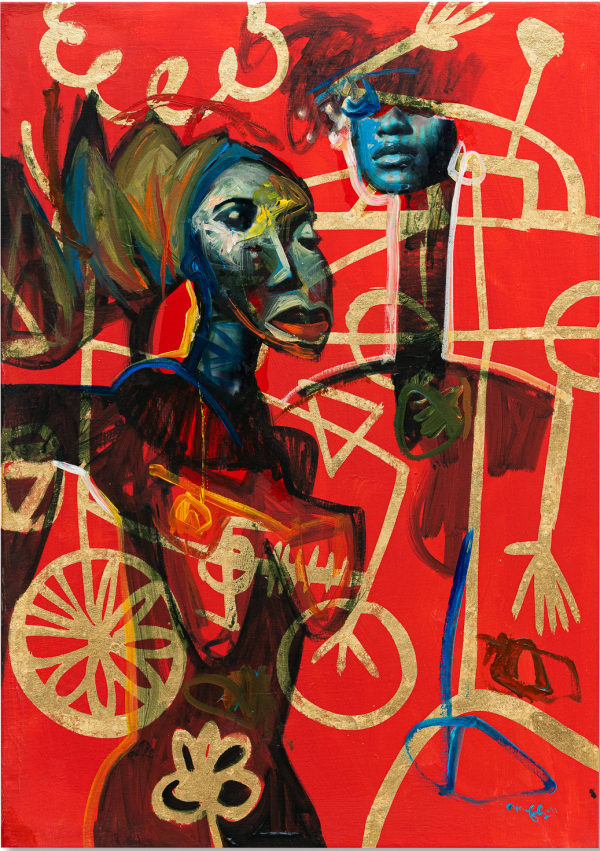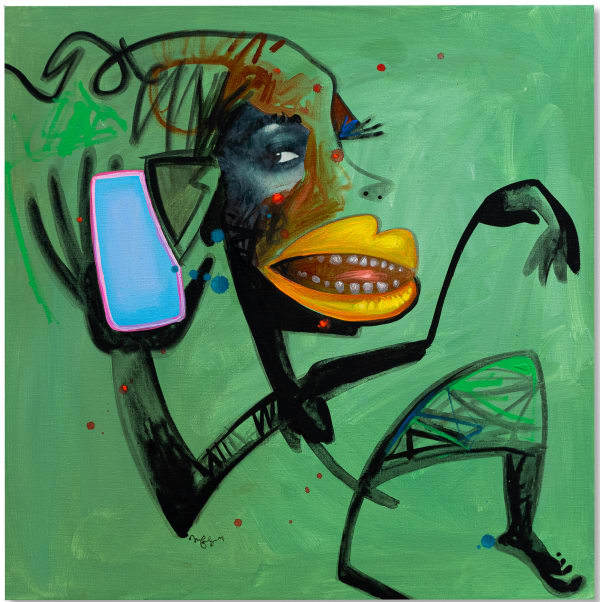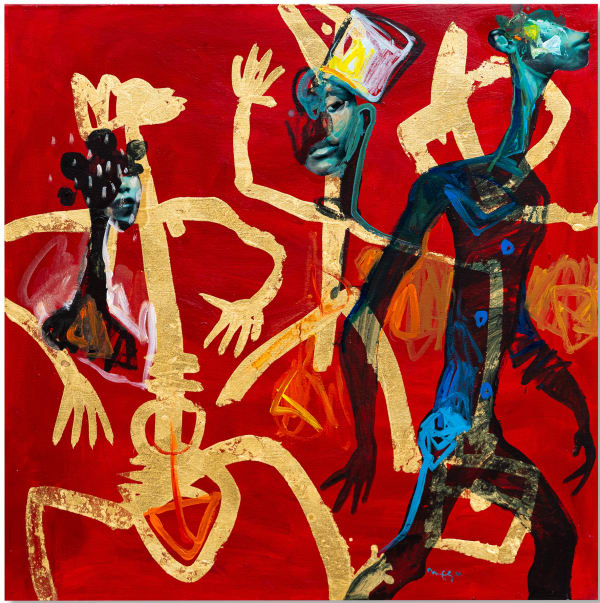We are pleased to present Papytsho Mafolo’s latest solo, ‘The Whisperings of the Stars’ as our first exhibition of 2022.
His first solo in South Africa, will present a large body of new works created during 2021 including several works in large scales.
The exhibition runs from 4 February until 6 March 2022 at The Melrose Gallery in Melrose Arch, Johannesburg
-
I come from a region that has been deeply marked by conflict. Much of this caused due to the richness of its natural resources. But in truth, its true wealth is our people - Papytsho Mafolo
-
-
About the exhibition
The Whispering of the Stars explores traditional African mythology and belief, that views the sky, the moon, and the stars as part of the Earth. In African mythology it is believed that celestial phenomena are natural signs united with the Earth in harmonious synchronicity.
This new body of work, created in 2021, continues to explore the realities of an African culture fragmented by foreign hegemony via figures half human and half animal dancing across his canvases.
These figures work to shift and mirror life, in constant dialogue with the sacred. Each passing moment becomes a call to listen to the whispers of the invisible lips of the spiritual world. What emerges is a view of nature as something imbued with a rich spiritual significance.
Born Congolese and now based in Belgium, Papytsho has spent a considerable amount of time living and working in Europe. The exhibition aims to question European-made identities and their influence on and relevance to those who are indigenous to Africa.
Seeing everything as relationally in conversation, Mafolo evokes this by collaging gold leaf, printed images, acrylic but also oil paint and unfinished lines on a canvas. These unfinished lines, according to Mafolo, evoke an infinite world but are also a self-reminder that artistically, he has not arrived yet.
Symbolically this represents how European identities were imposed on Africans by the colonisers to the detriment of the indigenous identities. African philosophy emphasizes this as it is based upon the belief that life is a vital unity and that the human being is only a point on the cosmic circle of life. The distinguishing features of this philosophy are its welfarism, altruism, universalism, and its utilitarian outlook.
Central to this is the near-universal lesson that ‘to be human is to affirm one’s humanity by affirming the humanity of others. Thus, individualism is what threatens humanity and the lines left unfinished in Mafolo’s work leave room for another, his spiritual self or you to finish.
This cultural mix, inherited by our time, must be seen as an opportunity towards perfection and not as an element of destruction of our values, because in this meeting of give and take everyone makes their contribution.
-
AYOKO MENSAH AND PAPYTSHO MAFOLO IN CONVERSATION
Ayoko and Papytsho will be filmining their discussion around issues of relevance to his career, life and practice on 11th Februrary in Belgium. This conversatiion will be uploaded on our social media platfroms on the 21st February.
Please note if you have any question to sumit to any of the panlist please sumbit this before the 9th February by 18h00 GMT+2 to curator@themelrosegallery.com
-
-

Ayoko Mensah
Ayoko Mensah is an arts programmer, cultural expert and author. Since 2016, she has been working at the Centre for Fine Arts in Brussels (BOZAR) where she is notably curator of the Afropolitan festival, an annual and multidisciplinary event dedicated to the African and Afro-descendant art scenes. Of Togolese heritage, born in France in 1968, Mensah is graduated in Cultural Management (MA) at University Paris-Dauphine (France), in Modern Literature (MA) at University Sorbonne Nouvelle (Paris) and in journalism (CFPJ, Paris). After having run Africultures review from 2005 till 2008 and founded and edited the magazine Afriscope in Paris, she worked as an expert for the UE-ACP (African, Caribbean and Pacific) ACPCultures+ programme at the ACP Secretariat in Brussels.
Since 2000, she also has worked as a consultant for several organisations (UNESCO, European Commission, International Organisation of Francophonie, Royal Museum for Central Africa, International Music Council) and has been invited as a speaker at international conferences in Africa, Europe, in the United States and in China.
Mensah also has co-authored several books, amongst others “Houn-Noukoun, Tambours & Visages” (1996), “Faustin Linyekula, choreographer” (2002) ; “A Body To Construct – The new generation of African Performance Artists” (2004); Créations artistiques en pays d’islam (2006); Kultur Afrika (2010); Djoliba, le grand fleuve Niger (2010). She is also regularly invited to participate in artistic juries.
-

Papytsho Mafolo
Born in the Démocratique République of Congo in 1977, Pitsho Mafolo's work depicts questions about the relativity between cultural identity and human behaviour.
He questions cultural identity crises and the historical heritage of human societies, with a particular emphasis on African culture.
Fragments of bodies half man and half animal often appear in his painting, which tell the realities of an African culture fragmented by foreign hegemony.
Open-minded, Mafolo does not hesitate to experiment with new styles and techniques after research or during new artistic encounters which results are reflected, moreover, by the energy that emerges in his works.
In practice, his techniques usually involve a collage of golden leaves, printed images, acrylic but also oil paint and unfinished lines on a canvas. These unfinished lines, according to Papytsho, evoke an infinite world but also as a self-reminder that artistically, he has not arrived yet.
Papytsho’s work is included in the permanent collections of the UNESCO collection (France), Rotary Club Collection (Kinshasa), Shell Collection on (Kinshasa), King of Jordan private Collection and the D.R. Congolese Presidential Collection.
-
-
For more information contact: curator@themelrosegallery.com
-
The presence of gold
-
I use gold leaf in my paintings to evoke the special being to gifts that we all possess. But also to celebrate when the black man is at one with his culture and his spirituality. I believe that we discover our true potential throughout our lives and build ourselves like a puzzle, borrowing here and there from others and our experiences.
-
 Papytsho MafoloThe Queen, 2019Mixed Media on Canvas100 x 200 cmSold
Papytsho MafoloThe Queen, 2019Mixed Media on Canvas100 x 200 cmSold -
 Papytsho MafoloMetropolitan Life , 2021Mixed media on canvas206 H x 213 W x 05 cm$ 17,400.01 $ 17,400.00
Papytsho MafoloMetropolitan Life , 2021Mixed media on canvas206 H x 213 W x 05 cm$ 17,400.01 $ 17,400.00 -
 Papytsho MafoloA Wonderful World , 2021Mixed media on canvas195 H x 254 W cm$ 14,150.00
Papytsho MafoloA Wonderful World , 2021Mixed media on canvas195 H x 254 W cm$ 14,150.00 -
 Papytsho MafoloDance Time , 2021Mixed media on canvas200 H x 250 W cm$ 15,000.00
Papytsho MafoloDance Time , 2021Mixed media on canvas200 H x 250 W cm$ 15,000.00 -
The earth is a beehive, we all enter by the same door.
-
 Papytsho MafoloNew Wind, 2021Mixed media on canvas205 x 335 x 7.5 cmSold
Papytsho MafoloNew Wind, 2021Mixed media on canvas205 x 335 x 7.5 cmSold -
Ngũgĩ wa Thiong'o writes, “To control a people’s culture is to control their tools of self-definition in relationship to others.” An important part of this cultural identity relies on the past, which in the case of Congo was created as “authentic traditional culture” by the modernist imagination of Belgian colonial rule, a cultural category from which change and modernity itself were scrubbed. - Sarah Van Beurden (Authentically African: Arts and the Transnational Politics of Congolese Culture)
This idea is of importance when viewing Mafolo’s artworks as they construct and visualize the city through the debris of its people. He uses visual art to depict and personify the city in which he lives and its people through the lens of his own personal history. Thus in his works, he explores the DRC and the changes that it has experienced due to colonialism, the struggle for independence, the stagnation of the Mobutu era, and most recently, the First and Second Congo Wars.
The circulation of objects and faces in Mafolo’s work leads to their appropriation and reinvention with the purpose of creating a more inclusive narrative. Becomes a device tool of which Mafolo draws upon when constructing his image, lines, colours, and shapes functioning in its multiplicity, displacement, and creative instability. Personifying how between black and white, old and new, home and abroad, art and artifact have their binary which by no means is stable nor does it exist in isolation. Thus the canvas upon which Papytsho pulls on this tension allows the subjects in his work to emerge as discursive instead of individual appropriations. The act as the city mirroring the other side embodying the rhythm of another whilst holding their own. Therefore, despite one’s story, a story does not exist in isolation nor is there a single story.
-Ruzy Rusike
-
 Papytsho MafoloRedefining Life, 2019Mixed media on canvas186 x 166 cmSold
Papytsho MafoloRedefining Life, 2019Mixed media on canvas186 x 166 cmSold -
-
 Papytsho MafoloTogether, 2019Mixed Media on Canvas165 x 185 cm$ 6,675.00
Papytsho MafoloTogether, 2019Mixed Media on Canvas165 x 185 cm$ 6,675.00 -
The iconography of diversity
-
 Papytsho MafoloOpen Mind , 2021Mixed media on canvas199 x 358 x 7.5 cmSold
Papytsho MafoloOpen Mind , 2021Mixed media on canvas199 x 358 x 7.5 cmSoldThis artwork speaks to 'openness of mind'. On the left of the painting, we have a lady who shows her hopelessness despite her potential. Next to her is a young boy whose expression highlights the daring that is often needed to go beyond the limits often set for us by those around us.
The women in green portray a change in attitude from one of helplessness to one of courage to stand up to our challenges thereby transforming into this golden character who occupies the center of the painting.
The golden woman symbolizes the state of self-awareness, of various innate capacities, possibilities and the putting into action of knowledge. This will cause great minds to bow to his presence. Great minds are illustrated by the figure in white with the guitar on his shoulder.
-
 Papytsho MafoloAnge, 2020Mixed media on canvas200 x 200 cmSold
Papytsho MafoloAnge, 2020Mixed media on canvas200 x 200 cmSold -
 Papytsho MafoloAll Lord All Honor , 2021Mixed media on canvas200 H x 238 W x 05 cm$ 14,750.00The woman that feature on my canvases play a very important role as it is through her that life is birthed as a symbolic representation of the cycle of life. Furthermore, at the last moment it is women who surround our remains before burial (In African culture) in short, she is a deity for me and the embodiment of beauty.
Papytsho MafoloAll Lord All Honor , 2021Mixed media on canvas200 H x 238 W x 05 cm$ 14,750.00The woman that feature on my canvases play a very important role as it is through her that life is birthed as a symbolic representation of the cycle of life. Furthermore, at the last moment it is women who surround our remains before burial (In African culture) in short, she is a deity for me and the embodiment of beauty. -
 Papytsho MafoloNatural Harmony , 2021Mixed media on canvas200 x 254 W cm$ 15,000.00
Papytsho MafoloNatural Harmony , 2021Mixed media on canvas200 x 254 W cm$ 15,000.00 -
 Papytsho MafoloShelter From Need, 2021Mixed media on canvas200 H x 240 W cm$ 14,750.00
Papytsho MafoloShelter From Need, 2021Mixed media on canvas200 H x 240 W cm$ 14,750.00 -
"No dance form is permeant, definitive, or ultimate. Changes occur, but the basic element of dance endures. Dance is for all people. One need only recall that dance needs neither common race nor common language for communication; it has been, and remains, a universal means of communication." - Kariamu Welsh-Asante
-
The Dance of Life
-
 Papytsho MafoloPower of Dance , 2021Mixed media on canvas200 x 200 cm$ 14,300.00
Papytsho MafoloPower of Dance , 2021Mixed media on canvas200 x 200 cm$ 14,300.00 -
language is the vessel through which time is expressed
The appropriate language with which to discuss the art of Africa and African Diaspora is a slippery issue that has grown in importance in the post-colonial epoch. In many ways the art world has not kept up with post-colonial realties – including a global economy, global politics, and a growing global awareness , and their impact on the production and perception of Africa and African Diasporic art. - Ogbechie, Sylvester Okwunodu (Exhibiting Africa: Curatorial attitudes and the politics of ...)
There is a lot of difficulty in defining a moment in African art or how art is produced in Africa. As most of the works are sculptures, paintings, ceramics, and land art, they evolve and react to time. Furthermore, terms such as ‘Primitive’, ‘Contemporary’, or ‘Afrofuturism’ are problematic when it comes to narrating this ongoing transformation. This art, African art and the diaspora, communicates consumption, industry, technology, taxation, labour, warfare, finance, insurance, government, bureaucracy, science, religion, and philosophy – all of this together was made possible by the ubiquity of slavery. Thus, we bond these concepts to concepts that are not our own. Therefore language is the vessel through which time is expressed which languge would you use to define Mafolo's works?
-
 Papytsho MafoloAncestral Hymn , 2021Mixed media on canvas200 H x 250 W cm$ 15,000.00
Papytsho MafoloAncestral Hymn , 2021Mixed media on canvas200 H x 250 W cm$ 15,000.00 -
From dream to reality
-
-
Should you be interested in any works please let us know and we will be in contact
-
I oftern spend time experiencing my own works. This results in a trans like state in which the works appear to have been done by another - Papytsho Mafolo






















